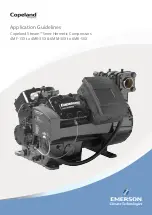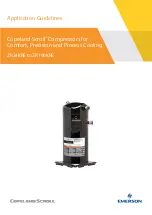
18
D
GB
F
E
I
Start- up
Preparations for Initial commissioning
The compressor has undergone trials in the factory and all functions have been tested.
There are therefore no special running-in instructions.
Before starting up, check the compressor for any signs of transport damage!
To protect the compressor from intolerable operating conditions, high- and low-
pressure pressostats. Comply with the accident prevention regulations!
Tightness test
Perform the tightness test of the refrigeration plant according to EN 378-2 (or a
corresponding safety standard)
without inclusion of the compressor
(preferably
dried with N2).
Do not mix any artificially refrigerant (e.g. R134a, R404A,... ) with the testing
medium, since otherwise shifting the ignition limit into the critical range is
possible.
Since significantly greater standstill pressures than permitted for the compressor
may arise, depending on the ambient temperature and refrigerant filling amount,
suitable measures must be taken on site to limit the standstill pressure in the
compressor to the permissible values (e.g. storage material, equalising reservoir,
pressure-keeping refrigeration system, pressure relief devices).
96020-07.06-DGbFEI
96020-07.06-DGbFEI
D
GB
F
E
I
96020-07.06-DGbFEI
96020-07.06-DGbFEI
17
Inbetriebnahme
Vorbereitungen zur Inbetriebnahme
Vorbereitungen zur Inbetriebnahme
Der Verdichter ist im Werk probegelaufen und auf sämtliche Funktionen geprüft worden.
Besondere Einlaufvorschriften müssen daher nicht beachtet werden.
Vor Inbetriebnahme Verdichter auf Transportschäden kontrollieren!
Um den Verdichter vor unzulässigen Betriebsbedingungen zu schützen, sind
Hoch- und Niederdruck-Pressostate zwingend erforderlich.
Unfallverhütungsvorschriften beachten!
Da in Abhängigkeit von Umgebungstemperatur und Kältemittelfüllmenge deutlich
höhere Stillstandsdrücke wie für den Verdichter zugelassen, auftreten können,
müssen anlagenseitig geeignete Maßnahmen ergriffen werden, die den Still-
standsdruck im Verdichter zuverlässig auf die zugelassenen Werte begrenzen
(z. B. Speichermasse, Ausgleichsbehälter, Druckhaltekälteanlage, Druckentla-
stungseinrichtungen).
Druckfestigkeitsprüfung
Druckfestigkeitsprüfung
Der Verdichter wurde im Werk auf Druckfestigkeit geprüft. Sofern zusätzlich die gesamte
Anlage einer Druckfestigkeitsprüfung unterzogen werden soll, ist zu beachten:
●
Kältekreislauf gemäß EN 378-2 (oder einer entsprechenden Sicherheitsnorm) prüfen.
●
Druckfestigkeitsprüfung vorzugsweise mit trockenem Stickstoff durchführen.
●
Verdichter in keinem Falle mit Luft abpressen.
● Dem Prüfmedium kein künstliches Kältemittel
(z.B.
R134a,
R404A
etc.) beimischen,
da sonst die Verschiebung der Zündgrenze in den kritischen Bereich möglich ist.
Gefahr! Während des gesamten Prüfvorgangs darf der maximal
zulässige Betriebsdruck des Verdichters nicht überschritten werden
(siehe Typschildangabe)!
Dichtheitsprüfung
Dichtheitsprüfung
Dichtheitsprüfung der Kälteanlage
Dichtheitsprüfung der Kälteanlage gemäß EN 378-2 (oder einer entsprechenden
Sicherheitsnorm)
ohne Einbezug des Verdichters
(vorzugsweise mit N
2
getrocknet)
durchführen.
Dem Prüfmedium kein künstliches Kältemittel (z.B. R134a, R404A etc.) beimischen,
da sonst die Verschiebung der Zündgrenze in den kritischen Bereich möglich ist.
To protect the compressor from intolerable operating conditions, high- and low-
pressure perssostats are required. Comply with the accident prevention regulati-
ons!
N
2
).
Evacuation
Firstly evacuate the plant,
then include the compressor
in the evacuation process.
- Pressure relieve the compressor
- Open suction and pressure shutoff valve.
- Evacuate with the vacuum pump on the suction and high pressure side.
- Vacuum < 1.5 mbar with shutoff pump.
- Repeat the process several times if necessary.
Do not start the compressor in vacuum. Apply no voltage – also not for test
purposes (may be operated only with refrigerant).
In the vacuum the spark-over and creepage current distances of the terminal board
connection bolts shorten, this can lead to winding and terminal board damage.
●
Firstly evacuate the plant,
then include the compressor in the evacuation process.
Check the compressor for any signs of transport damage!
Pressure strength test
The compressor was tested in the factory for pressure strength. If the entire plant should
be subjected in addition to a pressure strength test, then observe the following:
Test the cold circuit according to EN 378-2 (or a corresponding safety standard).
Perform the pressure strength test preferably with dry nitrogen (N
2
).
Do not mix any refrigerant with the testing medium (N
2
), since otherwise shifting the
ignition limit into the critical range is possible.
By no means the compressor may be pressure tested with oxygen or other
industrial gases!
The maximum permissible operating pressure of the compressor may not be
exceeded during the entire testing process (see name plate information)!
Do not mix any artificially refrigerant (e.g. R134a, R404A,... ) with the testing
medium, since otherwise shifting the ignition limit into the critical range is
possible.
Pressure strength test
The compressor was tested in the factory for pressure strength. If the entire plant should
be subjected in addition to a pressure strength test, then observe the following:
Test the cold circuit according to EN 378-2 (or a corresponding safety standard).
Perform the pressure strength test preferably with dry nitrogen (N
2
).
Do not mix any refrigerant with the testing medium (N
2
), since otherwise shifting the
ignition limit into the critical range is possible.
By no means the compressor may be pressure tested with oxygen or other
industrial gases!
The maximum permissible operating pressure of the compressor may not be
exceeded during the entire testing process (see name plate information)!
Summary of Contents for Pluscom HG34P Series
Page 26: ...26 D GB F E I...
Page 27: ...D GB F E I 27...











































